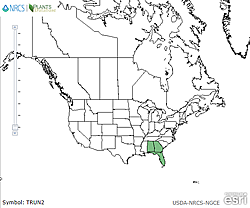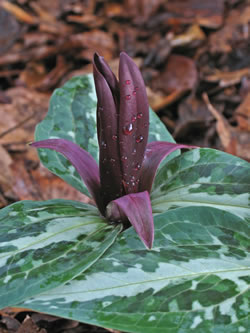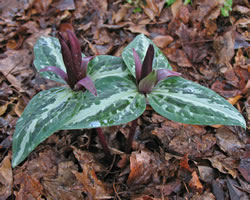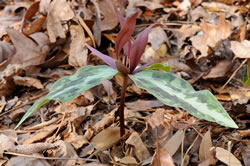Plant of the Week
 Trillium underwoodii range map. USDA PLANTS Database.
Trillium underwoodii range map. USDA PLANTS Database.
 Trillium underwoodii. Photo by Kevin Taylor.
Trillium underwoodii. Photo by Kevin Taylor.
 Trillium underwoodii. Photo by Kevin Taylor.
Trillium underwoodii. Photo by Kevin Taylor.
Longbract Trillium (Trillium underwoodii)
By Larry Stritch
All trillium species belong to the Liliaceae (lily) family and are rhizomatous herbs with unbranched stems. Trillium plants produce no true leaves or stems above ground. The “stem” is actually just an extension of the horizontal rhizome and produces tiny, scalelike leaves (cataphylls). The aboveground plant is technically a flowering scape, and the leaf-like structures are actually bracts subtending the flower. Despite their morphological origins, the bracts have external and internal structure similar to that of a leaf, function in photosynthesis, and most authors refer to them as leaves.
Trilliums are divided into two major groups, the pedicellate and sessile trilliums. In the pedicillate trilliums, either the flower sits upon a pedicel that extends from the whorl of bracts, “erect” above the bracts, or “nodding” recurved under the bracts. In the sessile trilliums, there is no pedicel and the flower appear to arise directly from the bracts.
Longbract trillium belongs to the sessile trilliums. Longbract trillium is a perennial herb that blooms from late February in the southern part of its range and into mid-April in the northern part of its range. The flower is quite showy sitting atop its mottled bracts.
This plant is typically found on very mesic soils to the drier soils deciduous forests. It occurs in southern Alabama, along the Georgia Alabama border and the Georgia Florida border.
For More Information
- PLANTS Profile - Trillium underwoodii, Longbract Trillium
- Flora of North America: Trillium underwoodii
- Case, F.W., R.B. Case. 1997. Trilliums. Timber Press, Portland, OR.
- Jacobs, D. L. and Jacobs R. L. 1997. Trilliums in Woodland and Garden: American Treasures. 152 pp. Eco-Gardens. Decatur, Georgia.



